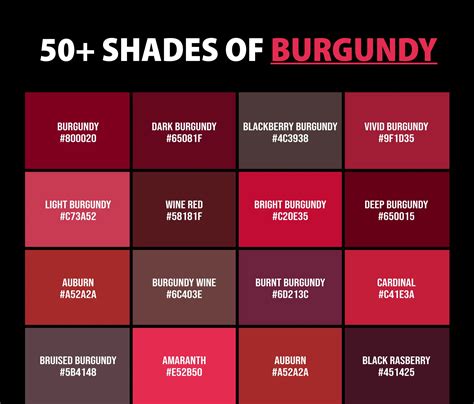Introduction

The world of fashion and design is filled with an array of beautiful colors, each with its own unique charm. Among these, maroon and burgundy stand out as two rich and sophisticated hues that often evoke feelings of elegance and warmth. However, despite their similarities, there are subtle differences between these two colors that can make a big impact in the overall appearance of a garment, accessory, or design.
Understanding the Color Spectrum
To fully grasp the distinction between maroon and burgundy, it’s important to understand the color spectrum. Colors are typically classified based on their hue, saturation, and value. Hue refers to the primary color that forms the basis of a shade, while saturation measures the intensity of the color. Value, on the other hand, indicates the lightness or darkness of a color.
Defining Maroon
Maroon is a deep reddish-brown color that falls on the cooler side of the spectrum. Its hue is similar to that of burgundy, but it has a higher saturation and a darker value. This results in a more intense and somber shade that often exudes a sense of mystery and sophistication.
Defining Burgundy
Burgundy is a deep purplish-red color that sits on the warmer side of the spectrum. Its hue is slightly different from maroon, with a more prominent presence of blue undertones. The saturation of burgundy is typically lower than that of maroon, giving it a more muted and elegant appearance.
Key Differences Between Maroon and Burgundy
- Hue: Maroon has a reddish-brown hue, while burgundy has a purplish-red hue.
- Saturation: Maroon is more saturated than burgundy, resulting in a more intense color.
- Value: Maroon is darker than burgundy, giving it a more somber appearance.
Where Maroon Shines
Maroon is an excellent choice for garments, accessories, and designs that aim to convey elegance, warmth, and a touch of mystery. It is often used in formal wear, such as suits, dresses, and evening gowns. Additionally, maroon can be found in interior design elements, such as curtains, upholstery, and paint, where it creates a sophisticated and inviting atmosphere.
Where Burgundy Reigns Supreme
Burgundy is a versatile color that can be used to create a wide range of looks, from elegant and sophisticated to warm and inviting. It is often seen in fashion accessories, such as scarves, ties, and handbags. Burgundy is also a popular choice for home décor, particularly in curtains, throw pillows, and bedding, where it adds a touch of warmth and luxury.
The Psychology of Color
Colors have a profound impact on our emotions and perceptions. Maroon is often associated with sophistication, stability, and authority. It can evoke a sense of confidence and power, making it a suitable choice for professional attire and formal occasions. Burgundy, on the other hand, is often associated with warmth, passion, and luxury. It can create a welcoming and inviting atmosphere, making it a popular choice for home décor and accessories.
Applications in Various Industries
- Fashion: Maroon and burgundy are widely used in the fashion industry, both for garments and accessories. They are often chosen for their sophistication, elegance, and ability to create a variety of looks.
- Interior Design: Maroon and burgundy are versatile colors that can be used to create both elegant and cozy interiors. They are often used in curtains, upholstery, and paint to add a touch of sophistication and warmth.
- Art and Design: Maroon and burgundy are popular choices for artists and designers due to their rich, vibrant hues. They are often used in paintings, sculptures, and other works of art to create a sense of depth and sophistication.
- Automotive: Maroon and burgundy are popular colors for automobiles, particularly luxury and sports cars. They convey a sense of elegance, power, and prestige.
- Cosmetics: Maroon and burgundy are used in a variety of cosmetic products, such as lipsticks, eyeshadows, and nail polishes. They create a sophisticated and dramatic look that is perfect for special occasions.
Useful Tables
| Attribute | Maroon | Burgundy |
|---|---|---|
| Hue | Reddish-brown | Purplish-red |
| Saturation | High | Low |
| Value | Dark | Light |
| Psychological Associations | Sophistication, stability, authority | Warmth, passion, luxury |
| Industry | Application | Example |
|---|---|---|
| Fashion | Garments, accessories | Suits, dresses, scarves, ties |
| Interior Design | Curtains, upholstery, paint | Drapes, sofas, walls |
| Art and Design | Paintings, sculptures, drawings | Portraits, landscapes, abstracts |
| Automotive | Luxury cars, sports cars | Ferraris, Lamborghinis |
| Cosmetics | Lipsticks, eyeshadows, nail polishes | Ruby red lipsticks, burgundy eyeshadows |
FAQs
- What is the difference between maroon and burgundy?
Maroon is a deep reddish-brown color, while burgundy is a deep purplish-red color. Maroon is more saturated and darker than burgundy.
- Which color is more versatile?
Both maroon and burgundy are versatile colors, but burgundy has a slight edge due to its warmer, more inviting hue.
- What are some popular applications for maroon and burgundy?
Maroon and burgundy are widely used in fashion, interior design, art and design, automotive, and cosmetics.
Conclusion
Maroon and burgundy are two rich and sophisticated colors that evoke feelings of elegance and warmth. While they share many similarities, subtle differences in hue, saturation, and value distinguish them. Maroon is a more intense, somber color that conveys sophistication and authority, while burgundy is a more muted, elegant color that exudes warmth and luxury. Understanding the nuances between these two colors can help you make informed decisions when choosing garments, accessories, home décor, or other items that will enhance your personal style and create the desired ambiance.
